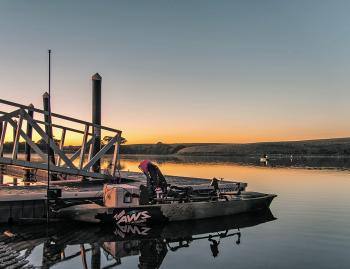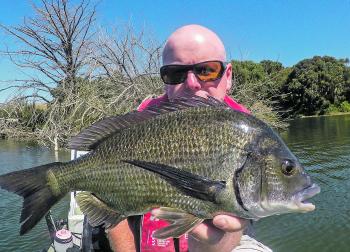In last year’s September issue, the Kayak Hotspot featured Warrnambool’s Hopkins River and specifically focused on the downstream sections of the river and in particular the ski run – definitely one of the better places to fish along the river during the cooler months.
As the water warms, fish spread out through the entire system, offering kayak anglers many different angling options. This makes summer and early autumn on the Hopkins a genuinely exciting time of year to be on the water. Recently I travelled back to Warrnambool to target fish further upstream while the water remained warm and fish were actively feeding on the edges.
Jubilee Park is the perfect launch site for kayak anglers looking to explore the upper reaches of the river. Home to a large caravan park, this area has plenty of accommodation options. Jubilee Park also features a well-appointed boat ramp. The ramp is concrete with twin floating pontoons as well as ample parking for trailered kayaks. Jubilee Park is positioned high in the tidal reaches of the river and gives anglers immediate access to some of the river’s most productive water.
Bream are a regular catch in the upper tidal areas of the Hopkins and most anglers fishing this area will have them high on their target list. Estuary perch are also prevalent in the area and fish to 40cm are regularly caught. Larger fish to 50cm are also a possibility. Mulloway enter the river regularly and if they are in the river they will often move high in the system in search of bait. It always pays to have a heavier rod on standby just in case the silver shadows show up.
For a smaller system, the Hopkins River has a lot of options for kayak anglers. One of my preferred techniques is to target fish holding on the rocky edges during the warmer months. The Hopkins River features many rocky banks, including several high limestone cliffs. Due to the limestone’s susceptibility to erosion, the cliffs are riddled with plenty of undercuts, caves and rock falls – a plethora of nooks and crannies – all perfect ambush spots for a hungry predator stalking its prey.
Casting a variety of hardbodied and soft plastics lures in amongst all this natural structure is a dynamite way of catching a bream. Crab imitation lures such as the Cranka Crab are a great starting point. Not only do crabs love to hide amongst all the rocks, they are also a favourite for any hungry bream looking for a meal.
When working crab lures I like to cast as close as possible to the edge, specifically looking for any crack or crevice that may be holding a waiting bream. Allow the crab to sink to the bottom and pause before twitching the lure subtly across the top of the rocks. Remember to pause regularly, as long pauses are often required. Be sure to use heavier leaders in the 6-10lb range. Bigger bream will quickly bust you off, so tight drags are best. This gives you the power to extract the fish from their snaggy homes before they bust you off on a jagged rock.
Grubs rigged on a weedless jighead such as a Decoy Nailbomb are another productive way to fish the rocky edges. Similarly, there are also a number of rocky reefs that extend out from the edges and are another excellent spot to target a bream with a crab or grub. The reefs are clearly marked with buoys and are always worth a look.
Along with the rock wall edges, the upper reaches are home to a number of shallow flats. These flats can be the perfect place to target estuary perch during periods of low light. Casting surface walkers, bent minnows or shallow diving hardbodies across the flats and working back to the kayak with an erratic twitch and pause retrieve is a great way of enticing a feeding perch.
Narrow profile paddle-tail plastics are another excellent way of fishing the flats. Rigged on a 1/12oz jighead and allowed to sink to the bottom, simply slow roll these across the bottom to get a result. Both bream and perch love minnow style soft plastics and they are a great way of actively targeting both species at the same time.
If a mulloway is your intended target, use your sounder to scan the deeper sections of the river looking for large returns. Normally the mulloway will be schooled in small groups, so finding them is the easy part. Getting them to bite on the other hand can be a very challenging task.
If you’re fortunate enough to get a hook-up, the resulting fight is well worth the effort and one of the most exciting experiences for any kayak angler. Mulloway will respond to a range of lures. A 4” paddle-tail plastic hopped along the bottom is my go-to technique.
The Hopkins is a popular waterway, for both anglers and other recreational users. The river can become busy with boat traffic, particularly during holiday periods. Taking measure to ensure you are highly visible and taking care during times of low light is recommended. As always, wear a good quality PFD and always carry a bailer on board, as required by Victorian law.
Any system that offers anglers a chance to hook and land the big three of Victorian estuary species all within a relatively short paddle must be worth a look in my opinion. The Hopkins has improved as a fishery in recent years and offers kayak anglers an outstanding, feature-rich, intimate waterway. The town of Warrnambool itself also has plenty to offer and is the perfect destination for a family holiday or a weekend away with friends. Make sure you remember to take the yak and experience first-hand what the upper reaches of the Hopkins have to offer.
Reads: 3486
Corey with an excellent example of what the Hopkins has to offer, a 1.4kg beast taken from a rocky point on a Cranka Crab.

Jubilee Park is the perfect launch site for kayak anglers wanting to fish the upper saltwater reaches.

The author with a 1kg+ bream extracted from a rocky nook.

Nathan Wright working his Pro Angler along a likely looking rock wall.

Bream are prevalent in the Hopkins and the main target for most anglers fishing the river.




